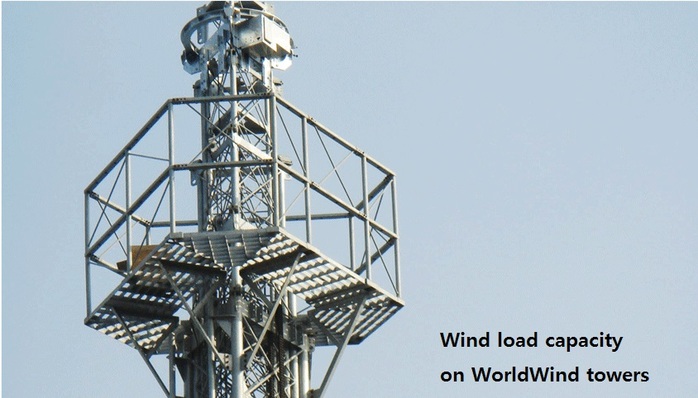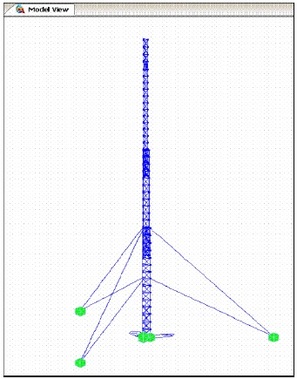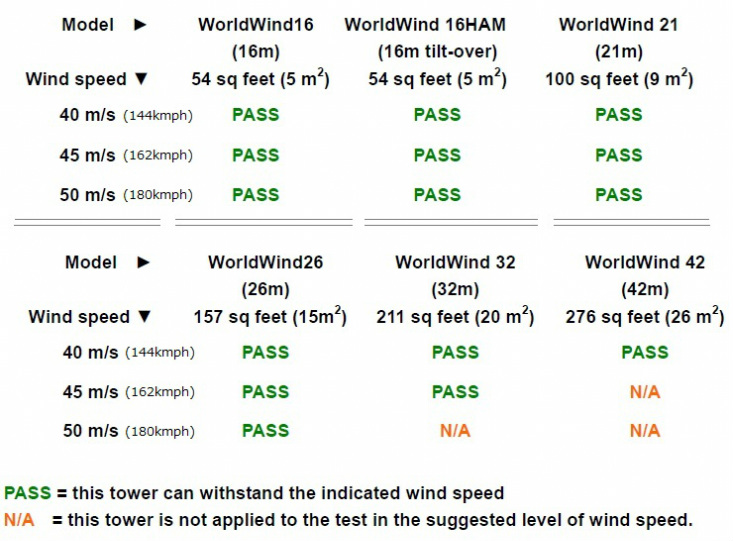Wind Load Capacity
Wind load capacity is a key factor in determining the overall strength of structures and is important in determining not only its ability to withstand winds but also its reserve capacity to withstand unanticipated events such as a major fire or impact damage. We would like to give you an information of wind load capacity of WorldWind, crank up tower made by Mecca Industry.
There is one thing what we want to say before letting you know the wind load capacity. We made a criterion on calculation of WorldWind, which is a national standard wind speed. We make a result like as 'when the wind speed is 50m/s, WorldWind can withstand or not'.
Wind Load Capacity of WorldWind towers
Results from structural engineering modeling software MIDAS/CIVIL 2008, MIDAS IT, Korea
NOTE : These results apply to the tower structure only, not for the tower with any antennas or attachment mounted on. There are too many variation to realistically model every possible combination of tower plus antennas, however these results will give you an indication of the strength of WorldWind towers. In a fixed installation you should also guy the WorldWind tower at the top and other points, increasing the wind loading capacity considerably.
1. Introduction
Wind loading capacity is a key factor in determining the overall strength and long-term safety of structures and is important in determining not only the structure’s ability to withstand winds but also its reserve capacity to withstand unanticipated events such as a major fire or impact damage.
Different countries use different standards for calculations - for example in Korea the national Standard Wind Speed for calculations is 45 m/s and in Japan the Standard Wind Speed for calculations is 42 m/s. On WorldWind towers we chose a maximum windspeed of 50 m/s (112 mph, 180 kph) for all our calculations - an extra safety margin over and above the national Standard Wind Speeds.
2. Software modelling parameters
The software was configured to repeat each test 3 times on each model of tower, using the guying configuration as shown in the diagram to the left (lowest section only guyed) and using the applied wind speeds as shown below :
There is one thing what we want to say before letting you know the wind load capacity. We made a criterion on calculation of WorldWind, which is a national standard wind speed. We make a result like as 'when the wind speed is 50m/s, WorldWind can withstand or not'.
Wind Load Capacity of WorldWind towers
Results from structural engineering modeling software MIDAS/CIVIL 2008, MIDAS IT, Korea
NOTE : These results apply to the tower structure only, not for the tower with any antennas or attachment mounted on. There are too many variation to realistically model every possible combination of tower plus antennas, however these results will give you an indication of the strength of WorldWind towers. In a fixed installation you should also guy the WorldWind tower at the top and other points, increasing the wind loading capacity considerably.
1. Introduction
Wind loading capacity is a key factor in determining the overall strength and long-term safety of structures and is important in determining not only the structure’s ability to withstand winds but also its reserve capacity to withstand unanticipated events such as a major fire or impact damage.
Different countries use different standards for calculations - for example in Korea the national Standard Wind Speed for calculations is 45 m/s and in Japan the Standard Wind Speed for calculations is 42 m/s. On WorldWind towers we chose a maximum windspeed of 50 m/s (112 mph, 180 kph) for all our calculations - an extra safety margin over and above the national Standard Wind Speeds.
2. Software modelling parameters
The software was configured to repeat each test 3 times on each model of tower, using the guying configuration as shown in the diagram to the left (lowest section only guyed) and using the applied wind speeds as shown below :
3. Results
In the results below, 50 m/s was the maximum wind speed used during calculations, giving a ‘Pass or Fail’ result for each model of WorldWind tower :
In the results below, 50 m/s was the maximum wind speed used during calculations, giving a ‘Pass or Fail’ result for each model of WorldWind tower :



